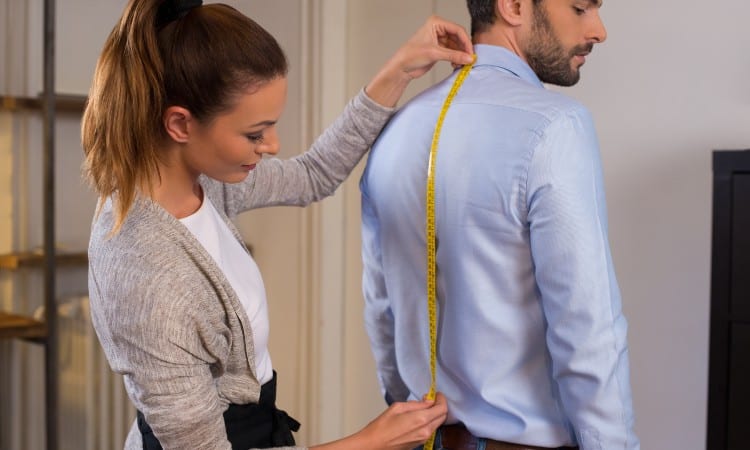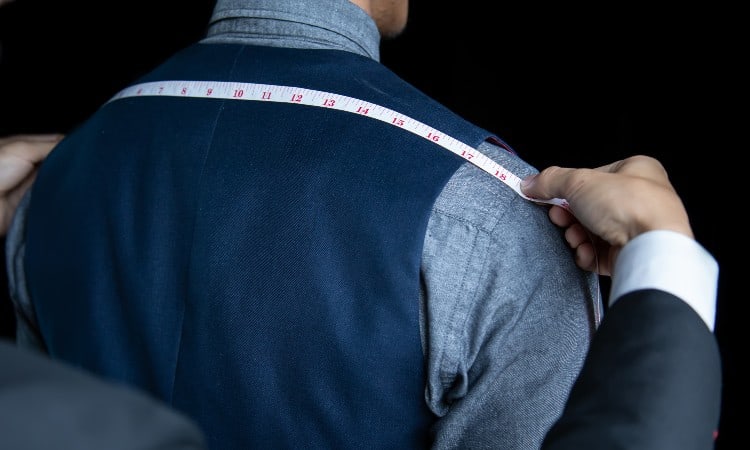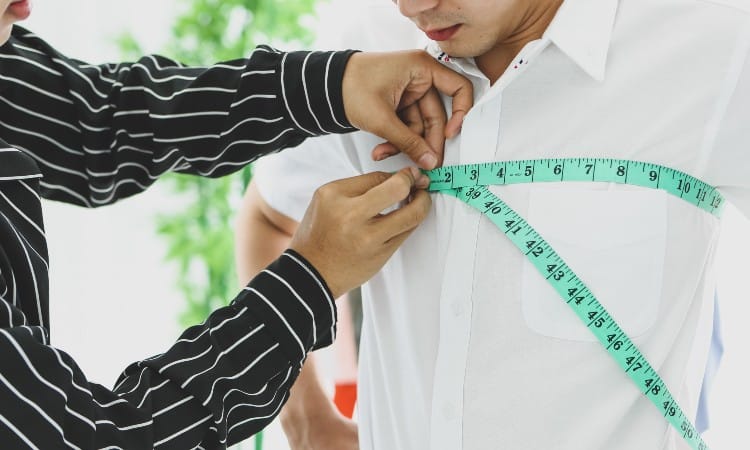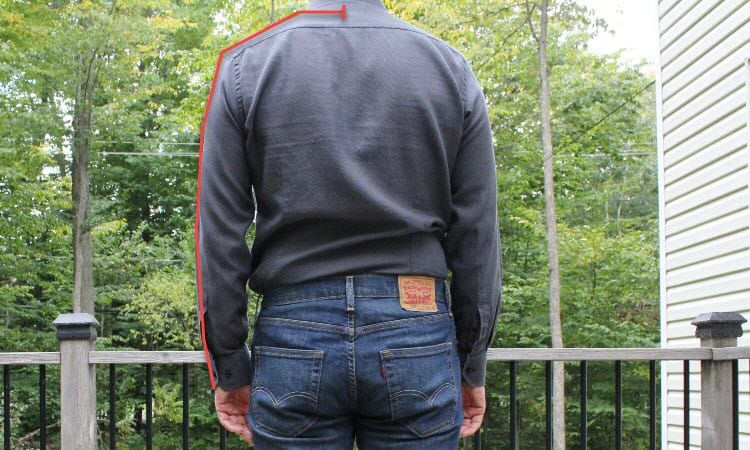Nothing looks as sharp and professional as a dress shirt perfectly fitted to the shape of your body. Men and women need the perfect dress shirt for work, pairing it with a suit for formal events or dressing down with khakis or jeans. But before you can find the perfect shirt for you, you need to learn how to measure for a dress shirt.
The key measurements for finding a dress shirt size include the neck and chest or bust circumference. Other important measurements include the length of the arm, the circumference of the bicep and wrist, and the width of the shoulders. In some cases, the shoulder-to-hem length may also help provide sizing information.
In this article, you will find out how dress shirt sizing works. You will learn how to take the key measurements you need to find your own dress shirt size. Finally, you will find tips on how to use sizing calculators.

Quick Navigation
How Does Dress Shirt Sizing Work?
The key to getting the right dress shirt size is understanding what measurements manufacturers use for both men’s and women’s shirts.
Men’s dress shirts often use a size that lists two numbers. The first number indicates the neck size, typically ranging from 13 to 19 inches. The second number lists the length of the sleeve, which usually falls between 32 and 37 inches.
Sometimes you will see three numbers because the sleeve size often comes in a range. For example, a shirt with a neck measurement of 13” and a sleeve length of about 33 inches might have a size written like this: 13 33/34. This indicates that the sleeve length falls between 33 and 34 inches.
Most shirt sellers will tell you the chest circumference and part of a sizing chart to help you pick the correct shirt for your body type.
For women’s shirts, sizing typically comes in an alphanumeric measurement. You may find either the even-numbered range of Sizes 2-16 or the standard S/M/L metric. Unfortunately, no two brands use precisely the same measurements to calculate sizes, so you will still want to refer to a sizing chart to find the right measurements for your body.
Whether you want to buy a men’s or a woman’s dress shirt, keep in mind that these shirts do not use standardized sizing. A women’s Size 4 button-down from Land’s End may have a different sleeve length or bust circumference than a Size 4 from Loft. Men’s dress shirts offer a bit more specificity as the measurements serve as the sizing metric, but you will still find variations in fit from one brand to another. A “slim fit from one brand will feel tighter than a “slim fit” cut from another brand, for example.
The best way to avoid going to dozens of different stores to try on shirts in person is to learn your measurements and use a seller’s sizing chart online to make sure you only buy shirts that match your measurements.
Another important factor to consider when buying a button-down shirt of any kind is that the fit matters just as much as the size. Different brands often use their own terms to describe the cut of a shirt. These might include athletic fit, regular fit, muscle cut, slim fit, tailored, extra-slim, or classic.
Each style will have its own particular shape. A tailored or extra-slim shirt will probably have concave side seams, highlighting a trim waist. Some more modern shirt styles will also offer shorter hemlines or tapered sleeves.
You will want to make sure you select a fit your feel comfortable wearing, as well as a size that has the same measurements as your body.
While you can easily take almost all of these measurements yourself in just moments, you can also visit a tailor, seamstress, or store that sells bespoke shirts to get your measurements taken by a professional.
How to Measure for a Dress Shirt
The best way to measure for a dress shirt for men is to take the neck, sleeve length, and chest measurements. For women, focus on the bust, waist, and sleeve length.
1. Neck

One of the key size determiners for men’s dress shirts is the neck circumference. You can easily take this measurement yourself with a flexible tape measure. Look for the kind of plastic or fabric tape that comes in most sewing kits.
- Stand with your shoulders relaxed and your back straight. Position yourself near a mirror so you can see the back of your neck.
- Wrap a tape measure around your neck, at its base, or below your Adam’s apple.
- Check the mirror to ensure that the tape has not sagged across the back of your neck. You want it to stay parallel to the floor all the way around.
- Next, carefully insert a finger beneath the tape. This will make sure you have a lose enough collar to feel comfortable when you buy a shirt.
- Write down the neck measurement.
2. Shoulder

In some cases, especially for very fitted or custom-order shirts, you may also want to take a shoulder width measurement.
It is worth noting that some shirt sellers and tailors incorporate the shoulder into the sleeve measurement, using the distance from the base of the neck and to the wrist as the sleeve measurement. Make sure you check what measurement a brand uses before buying a shirt from that company!
- Get a friend to help, if possible.
- Stand with a relaxed posture, both your feet flat on the floor.
- Have your friend place the tip of the tape where your shoulder ends or the shoulder seam ends in a dress shirt.
- Now ask them to smoothie eh tape across your upper back, over the curve of your spine at the base of your neck, and to the end of your other shoulder.
- Write down your shoulder width measurement.
3. Chest/Bust

Many men’s shirt sellers will list the chest size along with the neck and sleeve length to help men find a shirt large enough to fit. This is because, for many men, the chest forms the widest part of the torso.
If you have a stomach with a wider girth than your chest, measure the widest area of your stomach instead. This will help you get a shirt that comfortably fits your frame without straining at the buttons.
Many button-down shirts for women use artfully placed darts to create a 3D shape that fits the curves of your body. You want to make sure you get a shirt that fits you well enough that you do not have any gaps between the buttons!
The basic steps for the measuring technique work the same for men and women, though,
- Stand with your back to a mirror, your feet on the floor, and your shoulder relaxed.
- Do not breathe in deeply or flex your muscles.
- Wrap a flexible tape around the widest point of your chest or bust.
- Use the mirror to make sure you keep the measuring tape level all the way around.
- Pull the tape snugly but not so tightly that it presses into your skin at any point.
- Write down this measurement.
4. Waist
The waist measurement in women’s shirts makes a big difference as it shows a contrast between the bust and the most narrow part of the torso. For men, waist measurements are usually only necessary for shirts cut slim to show off a narrow torso.
- The first step is to find your natural waist. You can think of this as the point where you like the waistband of your pants to end or as the point just below your navel. You can also find this point by locating the narrowest portion of your waist.
- Set yourself up in front of a mirror to make sure you keep the tape level.
- Hold the short end of the tape in the center of your waist at the front, and wrap the tape around so that it circles your whole waist.
- Keep the tape pulled snugly but not too tight.
- Write down your waist measurement.
5. Sleeve Length

Men and women can easily take sleeve length measurements in the same way.
- Stand with both feet flat on the floor and relax your posture. Bend one arm slightly at the elbow.
- Next, place the short end of a measuring tape at the end of your shoulder or right where the shoulder seam ends on a shirt.
- Trace the tape down the outside of your arm, following the bend in your elbow. Stop when you reach the point at your wrist where you want a cuff to end.
- Write down the sleeve measurement.
6. Shoulder to Hem
A shoulder-to-hem measurement tells you the length of the shirt, letting you know where the hemline will end on your body. Not every manufacturer or brand will provide this information, but it’s helpful to know so you can quickly determine if a shirt will be too long or too short for you.
- Wear a shirt with a shoulder seam to help make this measurement work well.
- Place the tip of the tape measure at the shoulder seam right where it meets the shirt collar.
- Now let the tape fall straight down.
- Pinch the tape at the point where you would like the hem of your shirt to end, typically a bit below your natural waist.
- Write down the measurement.
You can also take this measurement on a shirt that fits you well. Simply spread it out flat on the floor, place the tip of the tape at that same point where the shoulder seam meets the collar, and smooth the tape straight down the shirt to its hem.
7. Bicep
Generally speaking, only custom-order men’s shirt companies require a bicep measurement. But this one is super easy, so you might as well write it down with your other dress shirt measurements!
All you have to do is wrap a tape measure around the widest portion of your bicep. Do not flex, as this will cheat your measurement.
8. Wrist

Men and women ordering custom-fit shirts may need a wrist measurement to get precisely fitted cuffs at the ends of long-sleeved shirts.
- Hold your non-dominant hand out in front of you.
- Wrap a tape measure around the bony wristbone circle of your wrist.
- Write down this measurement.
- Next, round up to the closest quarter inch.
- Keep in mind that most tailors add two inches to this measurement to provide the perfect-sized cuff that can easily slide over your wrist.
Dress Shirt Sizes Explained
Now that you know how to take accurate measurements, check out these answers to common dress shirt sizing questions.
What Does 32 33 Mean on a Dress Shirt?
Usually, 30-inch and up measurements on a dress shirt refer to the sleeve length. So 32/33 probably means that the shirt has a sleeve length of just over 32 inches.
However, the other key metric for a men’s dress shirt is missing. For men’s dress shirts, you almost always see neck size listed first, followed by the sleeve length. Common neck size measurements range from 13 inches to 19 inches from most brands.
What is a Size 17 34 35 Dress Shirt?
A size 17 34/35 dress shirt has a neck opening or collar with a 17” circumference and a sleeve length between 34 and 35 inches. If you compared that to common men’s t-shirt size, this size would roughly equate to a large or extra-large size.
What Size is a 16.5 Men’s Shirt?
Many brands selling dress shirts with neck sizes of 16.5 inches will have a chest size of roughly 40 inches. This equates to the average size medium men’s shirt.
Dress Shirt Size Calculator
You can find several free dress shirt size calculators online to help you pinpoint your measurements and sizing. Though these tools can helpfully guide you through the measuring process, the most accurate way to buy a shirt is still to get professionally measured at a high-end shop where you plan to buy shirts or to take your own measurements and match them to a seller’s sizing chart.
- Clothing Connection Online gives you easy estimates for dress shirts and suits for men. All you have to do is select your build, waist size, and height from easy drop-down menus to get a calculation for your best suit size.
- The Black Tux Blog offers a similar simple calculator. You input basic information, and the calculator guesses what size you will fit from most clothing brands.
- SizeCharter offers an easy solution for finding men’s and women’s clothing sizes and matching you to brands that might fit you well.
Men’s Shirt Size Chart
This sample chart will give you a good idea of the typical sizing and measurements offered for men’s dress shirts.
| Size | Neck | Sleeve Length | Chest |
| 14 32/33 | 14” | 32-33” | 34-36” |
| 15 33/34 | 15” | 33-34” | 38-40” |
| 16 34/35 | 16” | 34-35” | 42-44” |
How to Calculate Shirt Size by Height and Weight
Some shirt manufacturers offer charts or online calculators that guess what shirt size will fit you based on your height and weight. To be honest, this method works much better for t-shirts and hoodies than for dress shirts.
This is because dress shirts have many specifically fitted areas, such as the collar, the cuffs, and the length of the sleeves. No two people have the same body shape, so saying that you stand 5’7’ tall and weigh 200 lbs is not going to tell a shirt manufacturer the length of your arms!
That said, height and weight calculators like this one do provide the easiest method of sizing because all you have to do is input your height and weight.
How to Know Your Shirt Size Without Measuring
While the best way to find your precise shirt size is to take your measurements, you can also use a few quick hacks to know your approximate shirt size without measuring!
- Go through your closet and check the manufacturer’s labels inside your dress shirts. If 90% of your shirts are the same size, you can predict that you usually wear that size from most shirt sellers.
- Download an app that can estimate your sizes from your selfies. While not foolproof, apps like MySizeID offer a quicker alternative to a traditional measuring tape.
- Though it is less accurate than taking specific measurements, you can also use a height/weight calculator online to guess your shirt size. This is probably the quickest method if you need to guess your shirt size in a hurry!
Conclusion
For men’s dress shirts, the key to finding the right size for you is to accurately measure your neck and arm length. Men’s dress shirts use a sizing metric that lists the neck size in inches, followed by a range of sizes in an x/x format in inches for the sleeve length. Women’s dress shirts use an alphanumeric sizing system that depends on the bust and sleeve length measurements.
The best way to find the perfect dress shirt for you is to take these measurements and then compare them to a sizing chart provided by a company or seller. This way, you can buy a shirt that matches your measurements!